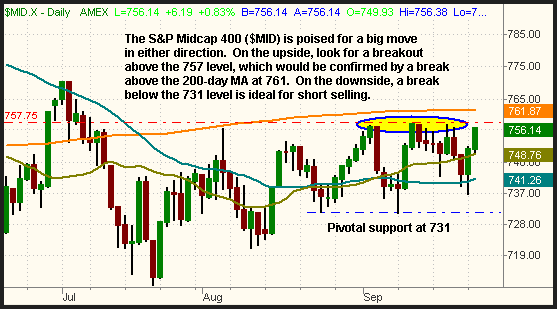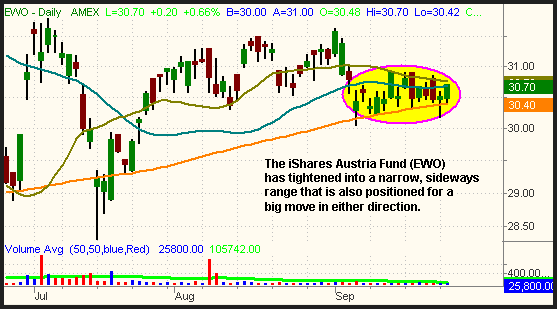Both the S&P 500 and Dow Jones Industrial Average zoomed 0.8% higher yesterday, enabling both indices to close at fresh five and a half year highs. The Nasdaq Composite lagged behind with a 0.6% gain, but the index still finished at its highest level since May of this year. The small-cap Russell 2000 advanced 0.8% and the S&P Midcap 400 rallied 0.4%. Each of the major indices finished at their intraday highs, indicating institutional support into the close. The surge to a new high in the S&P caused its hourly "head and shoulders" chart pattern to fail and stopped us out of our long position in the UltraShort S&P 500 ProShares (SDS), but the broad-based advance also moved our long position in the StreetTRACKS Homebuilders (XHB) deeper into the plus column. Continued relative weakness in the Semiconductor Index ($SOX) limited the advance in the Semiconductor HOLDR (SMH), which we remain short with an unrealized gain.
Despite the new high in both the S&P and Dow, total volume in the NYSE declined by 2%. Volume in the Nasdaq, however, was 9% higher than the previous day's level. It was the second consecutive "accumulation day" in the Nasdaq, but it would have been better if higher NYSE volume would have confirmed the breakout in the S&P. Market internals were positive, but not by a very wide margin. In the Nasdaq, advancing volume exceeded declining volume by a margin of less than 3 to 2. The NYSE ratio was positive by 5 to 2.
One index that is poised to make a big move in either direction is the S&P Midcap 400 Index ($MID). While the broad market has been rallying for the past two months, the $MID index has showed relative weakness by trading in a narrow, sideways range. Normally, such action would point to the potential for a selloff on the first broad market correction, but the tight consolidation could just as easily result in a high momentum snap to the upside. Looking at the daily chart of $MID below, notice how horizontal price resistance has clearly formed at the 757 level, but the index has been setting "higher lows" as well:

As you can see, the 200-day moving average resides at the 761 level, just a few points above the horizontal price resistance. While we would not buy any of the ETFs that track the S&P Midcap 400 until the index firmly closes above its 200-day moving average, such price action would represent a low risk entry on the long side. If the $MID pops to a new multi-month high above its 200-day MA, the pattern will attract buyers, which in turn will force the bears to cover any short positions. The end result would likely be a rapid upward move of at least several days. Conversely, it is just as much of a "no brainer" to sell short the $MID index if it breaks below the lower channel support at the 731 level. Obviously, we have no way of knowing for certain which direction the $MID index will break out, but a move out of its multi-month range in either direction should be good for a multi-day swing trade. We recommend setting alerts on your trading software for both a move above 761 and below 731. Then, rather than anticipating which direction it will resolve itself, you can simply react to the upside breakdown or downward breakdown. For now, however, we recommend avoiding the index until it figures out which direction it wants to go. The S&P Midcap SPDR (MDY) is the most popular ETF that mirrors the index, but you get more "bang for your buck" by trading the new leveraged ProShares ETFs instead. MVV is the ticker symbol for the ProShares Ultra MidCap 400, while MZZ is the ticker symbol for the UltraShort MidCap 400 ProShares. If the $MID index resolves itself to the downside, buying MZZ is much easier and requires less capital than selling short a comparable position in MDY.
On the international front, the iShares Austria Index (EWO) is another ETF that is positioned for a big move in either direction. After falling from its high throughout May and June, EWO began to recover, but was very choppy and erratic from June through August. It has tightened up into a narrow range since then, trading in only a 2% range for the past three weeks. This tight range is circled on the daily chart of EWO below:

As we often see with many stocks and ETFs, the 200-day moving average of EWO has been acting perfectly as support, pushing it ever so slightly higher. Both the 20 and 50-day moving averages have also converged in the vicinity of its current price, both of which will add further momentum to the eventual move out of the multi-week trading range. The longer it consolidates, the more dramatic the breakout or breakdown will be, so be prepared for a substantial move in this ETF. The pivotal resistance level for long entry is above the September 14 high of 30.90. For short entry, EWO would need to break below the September 7 low of 30.07. As a reminder, don't be concerned about the relatively low average daily volume of EWO. Remember that all ETFs are synthetic instruments that automatically move in sync with the underlying bid/ask prices of the stocks that comprise them. Therefore, liquidity is never an issue because an ETF's price movement is not based directly on its supply or demand.
Deron Wagner is the Founder and Head Trader of both Morpheus Capital LP, a U.S. hedge fund, and Morpheus Trading Group, a trader education firm launched in 2001 that provides daily technical analysis of the leading ETFs and stocks. For a free trial to the full version of The Wagner Daily or to learn about Wagner's other services, visit MorpheusTrading.com or send an e-mail to deron@morpheustrading.com.